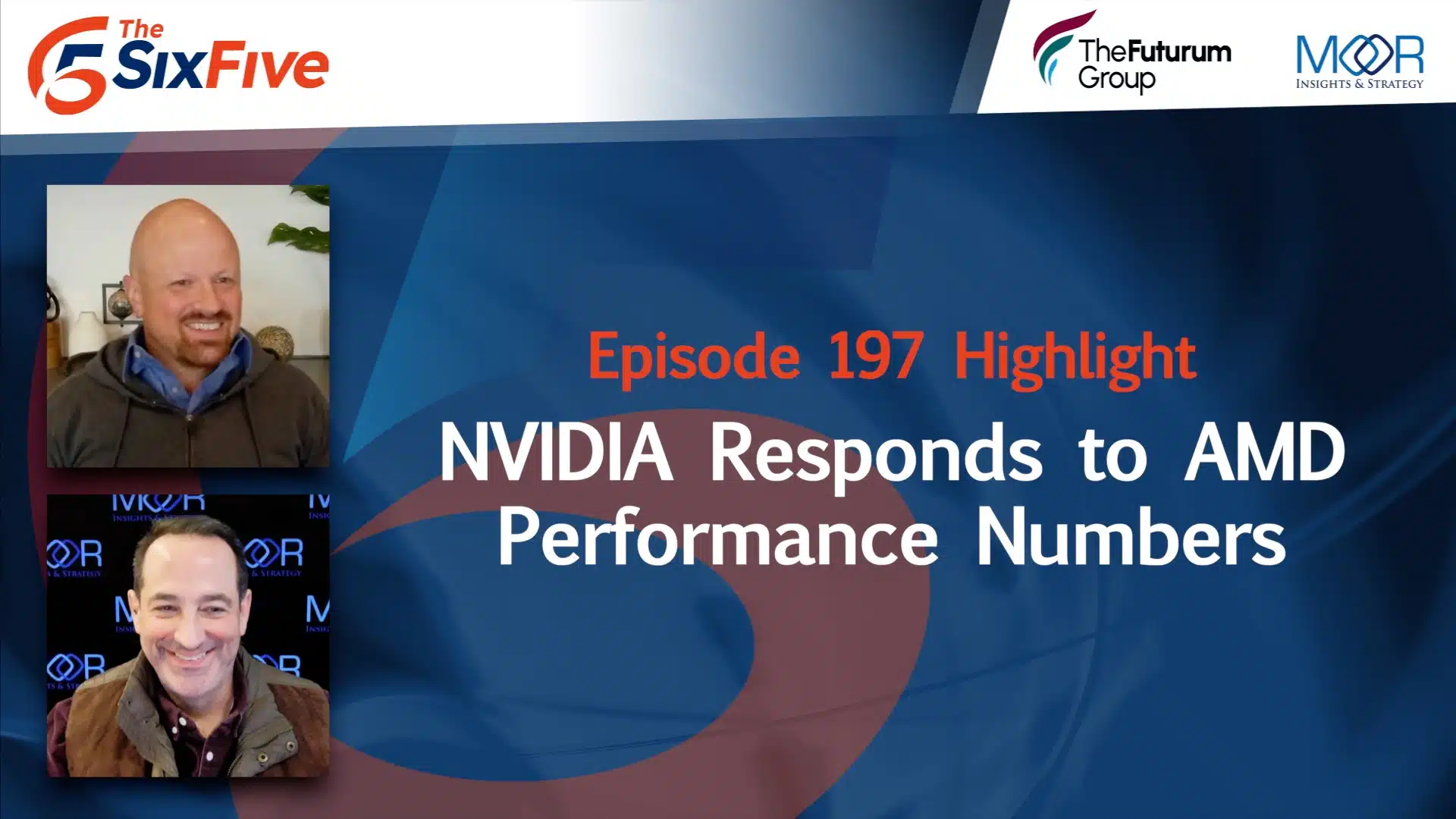The Six Five team discusses NVIDIA Responds to AMD Performance Numbers.
If you are interested in watching the full episode you can check it out here.
Disclaimer: The Six Five Webcast is for information and entertainment purposes only. Over the course of this webcast, we may talk about companies that are publicly traded and we may even reference that fact and their equity share price, but please do not take anything that we say as a recommendation about what you should do with your investment dollars. We are not investment advisors and we ask that you do not treat us as such.
Transcript:
Daniel Newman: NVIDIA and AMD, toe to toe, blow to blow. You had some great tweets, run us down.
Patrick Moorhead: Yeah, a little background. I’ve been in and around AMD and NVIDIA since the early ’90s, and I used to work for AMD, shocking, and have a pretty good idea, 13 years ago, but have a pretty good idea of how to read the two companies. And AMD had its AI day that we looked at. And Dan, you and I were there, met with basically the entire C-suite and AMD showed some very provocative numbers. They’ve done this before, right? They’ve shown big hardware numbers versus NVIDIA on AI. And more times than not, it ended up to be a big nothing burger because, A, software wasn’t ready. B, quite frankly, NVIDIA had bigger, bolder, badder hardware when it came to ML and DL and engine of AI.
But NVIDIA responded, which was to come out and basically say, “Hey, they’re measuring the wrong thing here.” And there was a lot of conversation on the interwebs. I mean, I had 50,000 people just weigh in on the conversation and another 100,000 weigh in on AMD and NVIDIA. So it really took a life of its own. But net-net what the arguments, again, whether you buy into 8 bit versus 16 bit, tokens in tokens out, the response back and forth from both NVIDIA, AMD just reinforces what I said at the show which was AMD has something real here, and they’re going to sell a bunch. I know AMD said, “Hey, we’ll sell two.”
I don’t know how that can’t be north of 5 billion next year just on this one product. Maybe it’s limited by TSMC and COAs and packaging. NVIDIA should have had a second source on here, but they didn’t. And competition is good. Dan, I love a horse in the game here, not pulling for NVIDIA, not pulling for AMD, I’m not pulling for Intel. What I pull for is open innovation and a lot of competition. Competition lowers prices, improves innovation, and it democratizes AI. And I think that we need to have this technology in more hands than we do today.
Daniel Newman: Hey, look, you had a great assessment. I really enjoyed following your stream this weekend.
Patrick Moorhead: Yeah, it’s a weekend semiconductor shit post.
Daniel Newman: Love it. I love it.
Patrick Moorhead: I’m already coming up with my Christmas post.
Daniel Newman: Rants and raves. Short, the TLDR here is one, AMD has NVIDIA nervous, and that’s probably the first time in some time that they’ve really felt a threat. And so you could tell because, one, that push on the H200, and two, that push to rebuke. Pat, one thing I’ve learned is when you’re not afraid and not threatened by someone’s overtures, you don’t react to them at all, right? I mean, that’s at least what I’ve seen is you didn’t see much of a reaction to claims from other companies that have come out.
Having said that, I mean, look, you and I have been very balanced on this topic. NVIDIA’s got a great lead, has done a wonderful job, has built a strong portfolio, has won the early adoption, and has been basically anointed the superpower of AI. And so anytime you’re on top, and you can ask the Intel of 10 years ago this question, there’s always going to be people out there that are rooting for either a fall, a demise, or at the very least for some more competition.
Pat, in a topic as important as AI, we need a diverse set of players offering competitive products that are bringing pricing, that are democratizing software, that are developing tools that can make this technology power and realize its potential economically, educationally, systemically. So I love that they’re battling. It’s good because after a year, NVIDIA didn’t have much of a battle to fight. So let’s bring it on AMD, and Intel joined the fray and all the cloud players and Rock and ANOVA and Graphcore, keep it coming. It’s good for the world.
Author Information
Daniel is the CEO of The Futurum Group. Living his life at the intersection of people and technology, Daniel works with the world’s largest technology brands exploring Digital Transformation and how it is influencing the enterprise.
From the leading edge of AI to global technology policy, Daniel makes the connections between business, people and tech that are required for companies to benefit most from their technology investments. Daniel is a top 5 globally ranked industry analyst and his ideas are regularly cited or shared in television appearances by CNBC, Bloomberg, Wall Street Journal and hundreds of other sites around the world.
A 7x Best-Selling Author including his most recent book “Human/Machine.” Daniel is also a Forbes and MarketWatch (Dow Jones) contributor.
An MBA and Former Graduate Adjunct Faculty, Daniel is an Austin Texas transplant after 40 years in Chicago. His speaking takes him around the world each year as he shares his vision of the role technology will play in our future.







